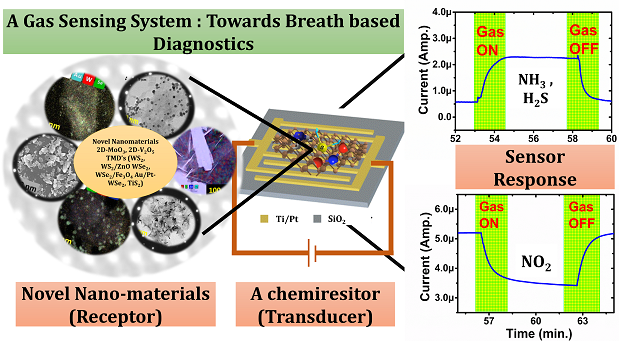Chemiresistive Gas sensors
Breath-based Diagnostics (BbD) can enable a paradigm shift in the Point-of-Care Diagnostic (PoCD) devices. Exhaled human breath has been demonstrated to contain over 2000 volatile organic and inorganic compounds, some of which report marked change in concentration under disease conditions. A sensitive, selective, cost-effective and portable gas sensing system could thus non-invasively diagnose multiple diseases from a single breath sample. However, to meet this requirement, there is a need to develop highly sensitive gas sensors with very low limits of detection (LLoD) down to ppb to ppt and high selectivity.
Therefore, we developed such chemiresitive gas sensors based on novel 2D nanomaterials and their hybrids while using a simple, scalable synthesis route. This contrasts with the conventional choice of sensing materials (metal oxides, polymers, CNTs etc.) and expensive fabrication methods. Here, we explored layered materials namely Transition Metal Dichalcogenides (TMDC) and layered Transition Metal Oxides (TMO) and their hybrids for the detection of Ammonia (NH3-50 ppb), Hydrogen Sulphide (H2S-300 ppb) and Nitrogen Dioxide ( NO2-50 ppb ); three important constituents of exhaled breath. The synthesis of these layered materials was carried out at room temperature via the Liquid Phase Exfoliation (LPE) technique using solvents with low boiling points. This technique is attractive because it is simple, scalable and does not require sophisticated instrumentation. Future research includes incorporating these sensors into a sensor array/matrix which subsequently can be integrated with electronics to develop a portable, hand-held diagnostic device.

Figure: (left) gas sensing system including transducer (Interdigitated Electrodes) embedded with receptor (2D nanomaterials), including their Microscopy images, (right) Dynamic response/recovery current characteristics in the presence of H2S, NH3 and H2S.
|
Professor |
Associate Professor |
Associate Professor |
Visiting Professor |
|
Visiting Professor |